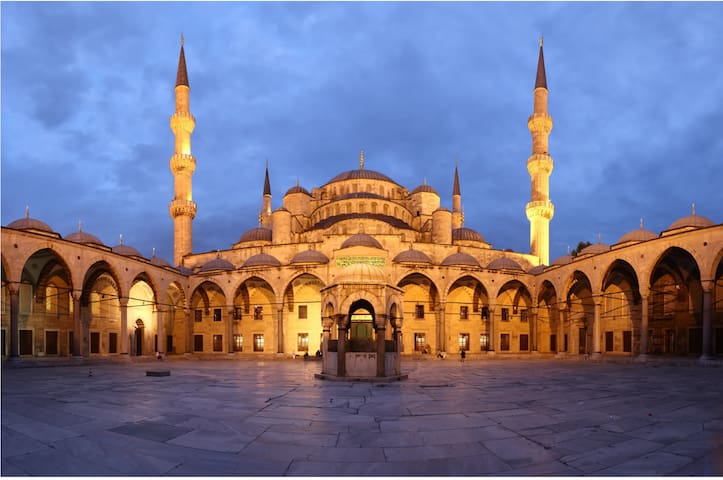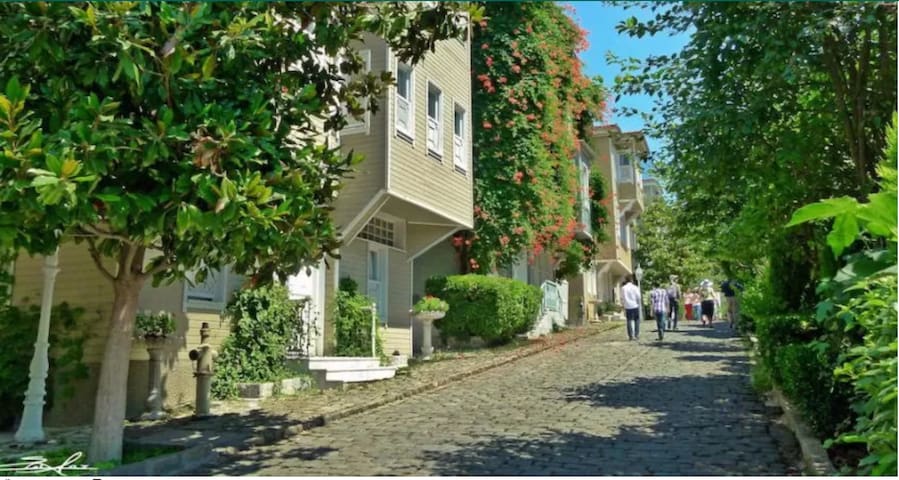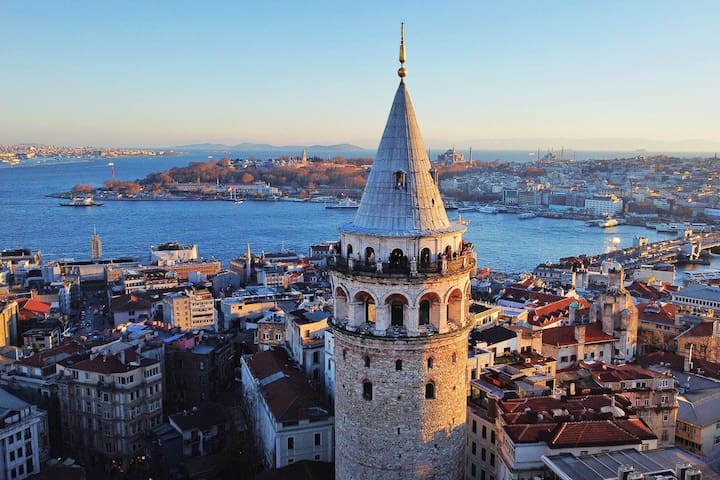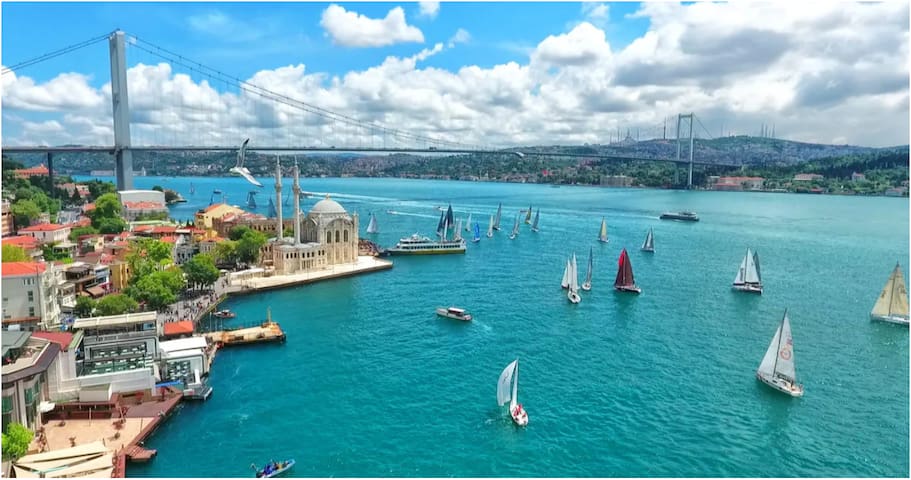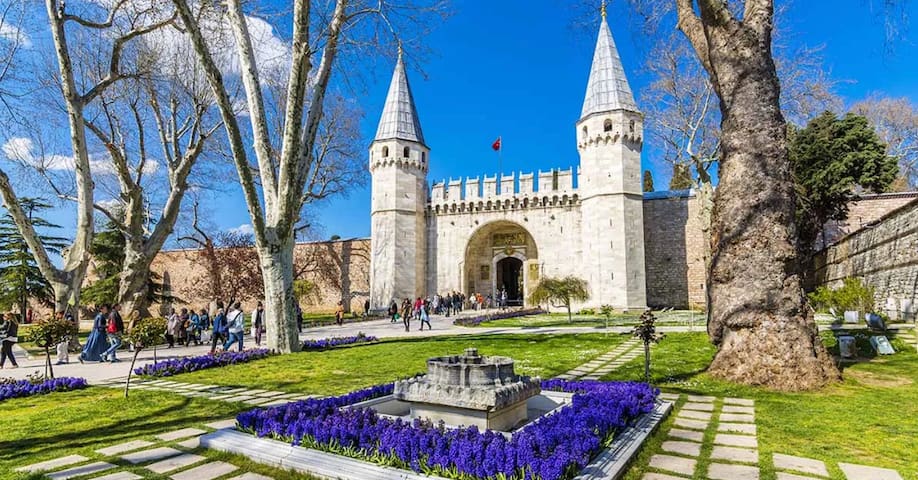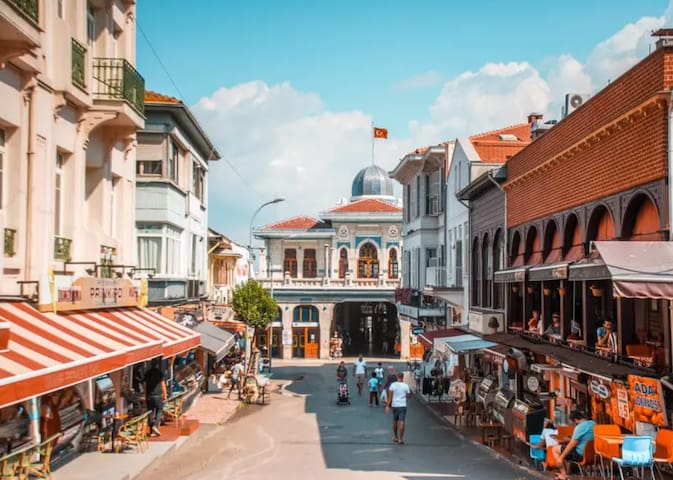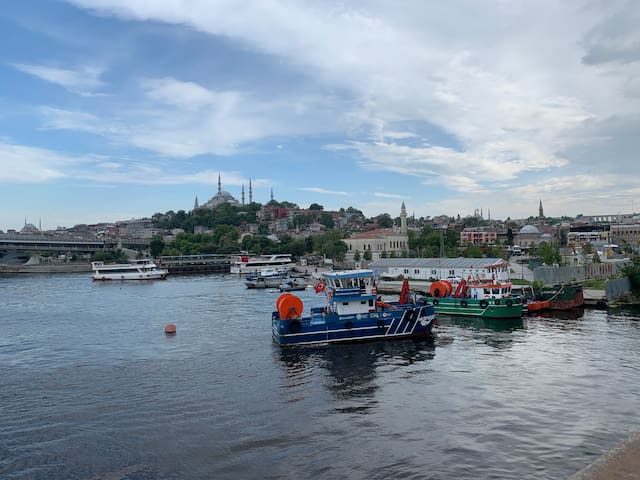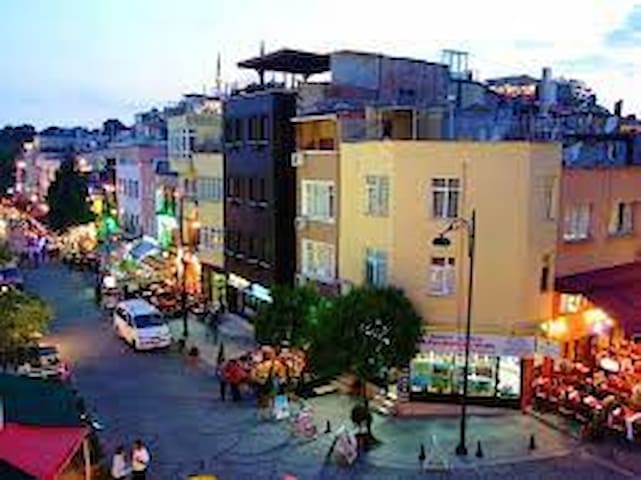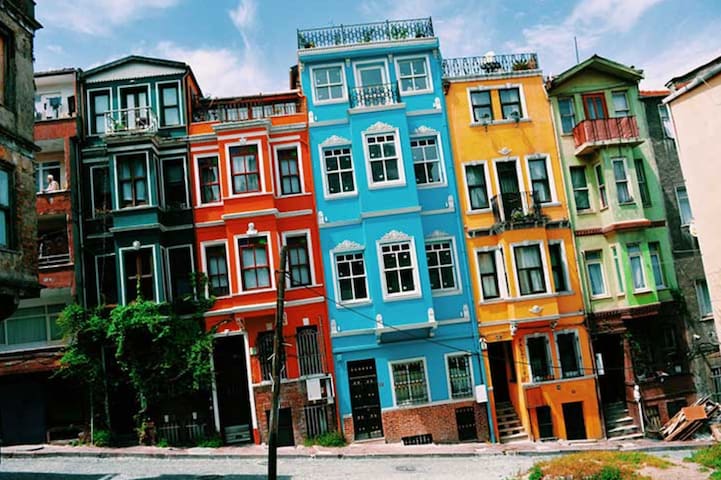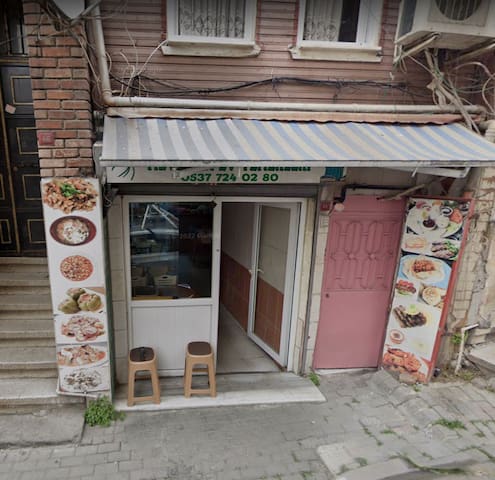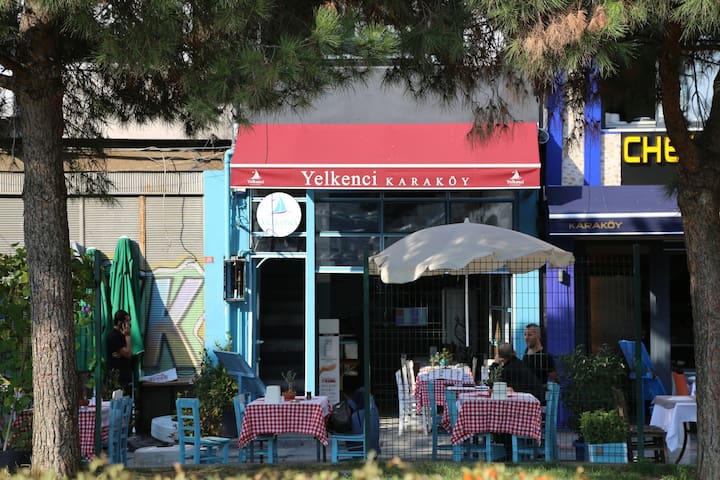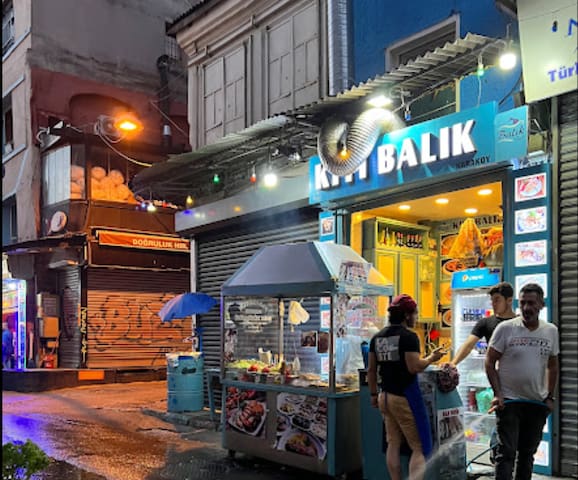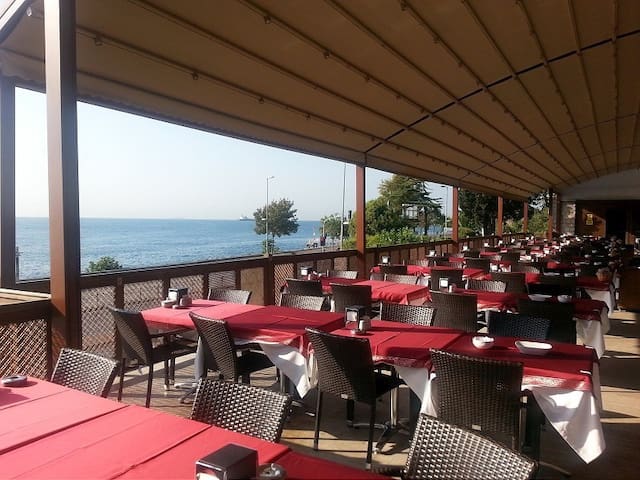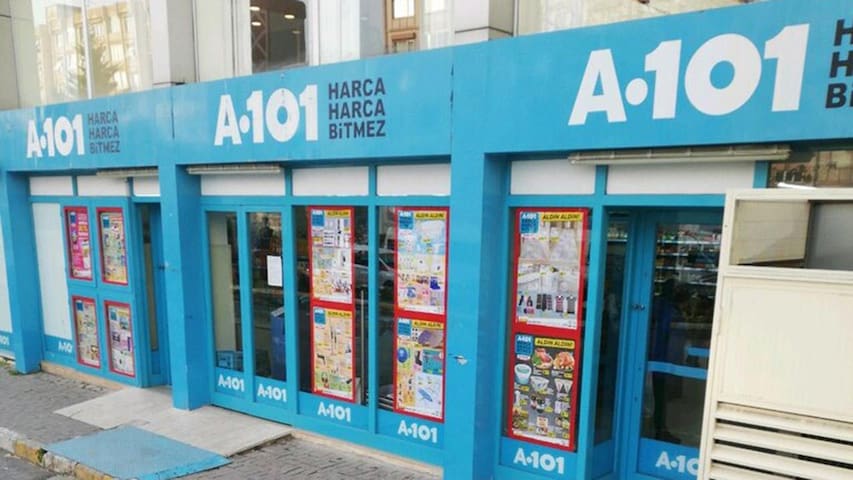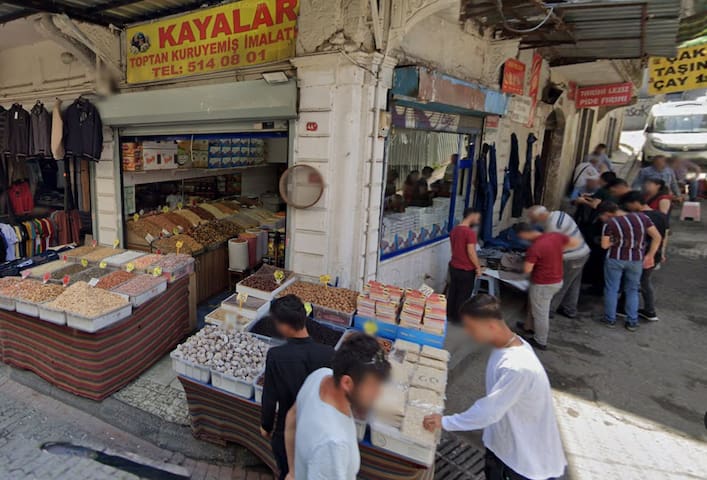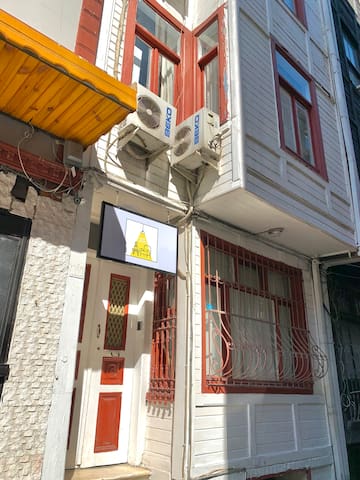Sightseeing
Suleymaniye Mosque is amazing and in my opinion, it is way better than Blue Mosque and Saint Sophia. The backyard of the mosque has a fantastic view of the Bosphorus. It is a marvellous work of architect Sinan the mosque is built in such way that Sinan even thought of landslides and ordered to build a wall all the way down in Demirtas district so it would prevent future landslides. The wall is very close to our location and you can follow the wall to the mosque or I will be more than happy to show you the way.
211 місцеві жителі рекомендують
Мечеть Сулейманіє
No:1 Prof. Sıddık Sami Onar Cd.Suleymaniye Mosque is amazing and in my opinion, it is way better than Blue Mosque and Saint Sophia. The backyard of the mosque has a fantastic view of the Bosphorus. It is a marvellous work of architect Sinan the mosque is built in such way that Sinan even thought of landslides and ordered to build a wall all the way down in Demirtas district so it would prevent future landslides. The wall is very close to our location and you can follow the wall to the mosque or I will be more than happy to show you the way.
Serefiye (Theodosius) Cistern Istanbul
Serefiye "Theodosius" Cistern was built between 428-443. Emperor Theodosius ordered the construction of this Cistern in Istanbul, which is why it is called his name. One of the three cisterns of Significant Costantinopolis (with the 4th-century Binbirdirek Cistern and the 6th-century Basilica Cistern). The water was brought to the city from the Belgrade Forest by the Aqueduct of Valens.
What time is the Serefiye Cistern open?
It is open every day between 09:00 - 19:00. The last entrance is at 18:00.
Note that entrance can only be done with their guide.
26 місцеві жителі рекомендують
Шерефієва Сарніця
No:2/1 Piyer Loti Cd.Serefiye (Theodosius) Cistern Istanbul
Serefiye "Theodosius" Cistern was built between 428-443. Emperor Theodosius ordered the construction of this Cistern in Istanbul, which is why it is called his name. One of the three cisterns of Significant Costantinopolis (with the 4th-century Binbirdirek Cistern and the 6th-century Basilica Cistern). The water was brought to the city from the Belgrade Forest by the Aqueduct of Valens.
What time is the Serefiye Cistern open?
It is open every day between 09:00 - 19:00. The last entrance is at 18:00.
Note that entrance can only be done with their guide.
During the rule of Ahmed the First, this palatial site served as more than a place of worship. It also served as a tomb for the ruler, as a madrasah, and as a hospice. Today, the mosque itself serves as a holy temple for many of the residents of Istanbul, Turkey, and is the highlight of the city itself.
As one of the first mosques in Turkey to have six minarets, the Sultan Ahmed Mosque was somewhat controversial post it’s construction by Sultan Ahmet I in 1616 due to the fact that the Kaaba in Mecca also boasted the same number, and the Sultan resolved the issue by ordering a seventh minaret at the holy site. There are five main domes that overwhelm the senses with the finest elements of Byzantine Christian and Ottoman elements from the classical period, and the interiors are just as captivating as the exterior of the mosque.
While the lower levels and piers are line with over 20,000 Iznik style ceramic tiles crafted by hand, the upper levels are dominated by intricate designs of various hues of blue paint. Over 200 spectacular stained glass windows permit the glorious natural light to penetrate the interior, which activates the crystalline magnificence of the many chandeliers.
VISITOR INFORMATION
Because this site serves as an active mosque, visiting hours are open 7 days a week, 24 hours a day; however, during times of prayer, the mosque is closed to visitors for about an hour and a half. Hours may also be varied during Islamic holidays and festivals. Please note, that all visitors are required to wear appropriate, modest attire and cover their heads before entering the mosque. Staff is happy to provide loaned scarves and head coverings at the entrance.
803 місцеві жителі рекомендують
Синя мечеть
No:10 Atmeydanı Cd.During the rule of Ahmed the First, this palatial site served as more than a place of worship. It also served as a tomb for the ruler, as a madrasah, and as a hospice. Today, the mosque itself serves as a holy temple for many of the residents of Istanbul, Turkey, and is the highlight of the city itself.
As one of the first mosques in Turkey to have six minarets, the Sultan Ahmed Mosque was somewhat controversial post it’s construction by Sultan Ahmet I in 1616 due to the fact that the Kaaba in Mecca also boasted the same number, and the Sultan resolved the issue by ordering a seventh minaret at the holy site. There are five main domes that overwhelm the senses with the finest elements of Byzantine Christian and Ottoman elements from the classical period, and the interiors are just as captivating as the exterior of the mosque.
While the lower levels and piers are line with over 20,000 Iznik style ceramic tiles crafted by hand, the upper levels are dominated by intricate designs of various hues of blue paint. Over 200 spectacular stained glass windows permit the glorious natural light to penetrate the interior, which activates the crystalline magnificence of the many chandeliers.
VISITOR INFORMATION
Because this site serves as an active mosque, visiting hours are open 7 days a week, 24 hours a day; however, during times of prayer, the mosque is closed to visitors for about an hour and a half. Hours may also be varied during Islamic holidays and festivals. Please note, that all visitors are required to wear appropriate, modest attire and cover their heads before entering the mosque. Staff is happy to provide loaned scarves and head coverings at the entrance.
Far below the city streets of Istanbul lies the largest of the ancient cisterns, Basilica Cistern, or Yerebatan Sarayi, the “Sunken Palace”. This immense cistern was built during the heyday of the Roman Empire and Constantinople. Visitors can easily arrange a visit below the old city to this surreal underground treasure.
A Jewel Below Your Feet
The Basilica Cistern is a wonder of ancient Roman architecture that can only be glimpsed below the streets of modern Istanbul. The Basilica Cistern is an awe-inspiring cistern, one of several hundred such structures, built during the reign of Byzantine Emperor Justinian during the 6th century. The ancient cisterns provided a water filtration system for buildings throughout the ancient city and were used throughout the Ottoman Conquest and even today. The Basilica Cistern provided water for the Great Palace of Constantinople and other structures on First Hill.
Visitors can expect an underground chamber approximately 138 meters by 64.6 meters and capable of containing 80,000 cubic meters of water. 336 marble columns support the ceiling of the structure and the weight of the city above. Each column is 9 meters high and capped with capitals of Ionic, Corinthian and Doric styles. Engravings can be spied such as the relief of a Hen’s Eye, tears and slated branches, reminiscent of the columns of the Triumphal Arch of Theodosius. Some texts suggest that the tears pay tribute to the slaves that died during construction. Elements of columns seem to have come from previous buildings, a common practice during that period. Look for the two Medusa visages of unknown origin at the base of two of the columns. After restorations throughout the ages, the cistern was made available to the public on September 9th, 1987.
Plan Your Trip
Visitors walk down a series of stone steps to enter the cistern. Plan to spend 1-2 hours at the site with opening times that vary. Visit the Basilica Cistern seven days a week with winter opening hours of 9am to 5:30pm and from 9am to 6:30pm during the summer. There are a few holiday exceptions, as noted on their website. This institution is not affiliated with the Ministry of Culture and any Museum Cards are not valid at this site. To contact staff directly, call +0 212 512 15 70 and stay abreast of any changes with a visit to their website.
638 місцеві жителі рекомендують
Базиліка Цистерна
1/3 Yerebatan Cd.Far below the city streets of Istanbul lies the largest of the ancient cisterns, Basilica Cistern, or Yerebatan Sarayi, the “Sunken Palace”. This immense cistern was built during the heyday of the Roman Empire and Constantinople. Visitors can easily arrange a visit below the old city to this surreal underground treasure.
A Jewel Below Your Feet
The Basilica Cistern is a wonder of ancient Roman architecture that can only be glimpsed below the streets of modern Istanbul. The Basilica Cistern is an awe-inspiring cistern, one of several hundred such structures, built during the reign of Byzantine Emperor Justinian during the 6th century. The ancient cisterns provided a water filtration system for buildings throughout the ancient city and were used throughout the Ottoman Conquest and even today. The Basilica Cistern provided water for the Great Palace of Constantinople and other structures on First Hill.
Visitors can expect an underground chamber approximately 138 meters by 64.6 meters and capable of containing 80,000 cubic meters of water. 336 marble columns support the ceiling of the structure and the weight of the city above. Each column is 9 meters high and capped with capitals of Ionic, Corinthian and Doric styles. Engravings can be spied such as the relief of a Hen’s Eye, tears and slated branches, reminiscent of the columns of the Triumphal Arch of Theodosius. Some texts suggest that the tears pay tribute to the slaves that died during construction. Elements of columns seem to have come from previous buildings, a common practice during that period. Look for the two Medusa visages of unknown origin at the base of two of the columns. After restorations throughout the ages, the cistern was made available to the public on September 9th, 1987.
Plan Your Trip
Visitors walk down a series of stone steps to enter the cistern. Plan to spend 1-2 hours at the site with opening times that vary. Visit the Basilica Cistern seven days a week with winter opening hours of 9am to 5:30pm and from 9am to 6:30pm during the summer. There are a few holiday exceptions, as noted on their website. This institution is not affiliated with the Ministry of Culture and any Museum Cards are not valid at this site. To contact staff directly, call +0 212 512 15 70 and stay abreast of any changes with a visit to their website.
In the old city of Istanbul lies one of the glories of the ancient world, the Hippodrome of Constantinople. This was a center of entertainment for the Byzantine Empire and now can be found at the Sultanahmet Meydani, or Sultan Ahmet Square. Visitors that seek enlightenment on the entertainment of another age must add the Hippodrome of Constantinople as one of their stops while in Istanbul.
The Hippodrome of Constantinople was Constantinople’s circus during the Byzantine Empire. It was here that lavish sporting events and socializing took place to flame the passions of citizens. Horse and chariot racing were commonly performed in this structure that predates the period of Constantine.
Built when the city was known as Bysantium, the Emperor Septimus Severus added the hippodrome in AD 203. When Emperor Constantine the Great moved the seat of government to Byzantium or Nova Roma in AD 324, he renovated the Hippodrome. At this time, the Hippodrome was 450 meters long and 130 meters wide and could hold 100,000 spectators. There was a U-shaped race track with the emperor’s lodge at the eastern end of the track. Great statues of horses, chariot drivers, emperors, heroes, and gods once filled the area. The city’s social life centered around the activities in this structure with huge bets on races, supported by Constantinople’s political parties in the Senate. The Hippodrome fallen into ruin by 1453.
People visiting the Hippodrome today can see three monuments of the original Hippodrome on site. The Serpent Column, the Obelisk of Thutmose III and the Walled Obelisk can be easily viewed, as well as the middle barrier of the racecourse, all in a landscaped garden. The Obelisk of Thutmose the III is striking, rising 60 meters and weighing 800 tons. It was constructed by the Pharaoh Tutmos III during his reign from 1549-1503 B.C. It was erected in Constantinople in 390. Made of pink granite, the marble base shows a relief of the Emperor and his family watching chariot races and makes reference to the Sun God Amon Ra. All of the monuments and decorations at the time were intended to showcase the greatness of Constantinople to the world. Other elements of the Hippodrome can be seen at the Istanbul Archaeological Museum.
Plan Your Visit
The area is now a public park, named At Meydani, or “Horse Grounds”. On a nice day, visitors can easily walk the grounds without worrying about opening hours or entrance fees. The park is Wi-Fi accessible. With such a rich and colorful history, a tour would be the best way to reimagine what happened on site and what life was like throughout the ages.
On a clear day, the Hippodrome is an easy way for visitors to stretch the legs and imagine the social center of the Byzantine period. An accessible public park allows individuals to view the structures and area on their own schedule and can be an excellent stop between other indoor sites.
368 місцеві жителі рекомендують
Площа Султанахмет
No:2 Sultan Ahmet ParkıIn the old city of Istanbul lies one of the glories of the ancient world, the Hippodrome of Constantinople. This was a center of entertainment for the Byzantine Empire and now can be found at the Sultanahmet Meydani, or Sultan Ahmet Square. Visitors that seek enlightenment on the entertainment of another age must add the Hippodrome of Constantinople as one of their stops while in Istanbul.
The Hippodrome of Constantinople was Constantinople’s circus during the Byzantine Empire. It was here that lavish sporting events and socializing took place to flame the passions of citizens. Horse and chariot racing were commonly performed in this structure that predates the period of Constantine.
Built when the city was known as Bysantium, the Emperor Septimus Severus added the hippodrome in AD 203. When Emperor Constantine the Great moved the seat of government to Byzantium or Nova Roma in AD 324, he renovated the Hippodrome. At this time, the Hippodrome was 450 meters long and 130 meters wide and could hold 100,000 spectators. There was a U-shaped race track with the emperor’s lodge at the eastern end of the track. Great statues of horses, chariot drivers, emperors, heroes, and gods once filled the area. The city’s social life centered around the activities in this structure with huge bets on races, supported by Constantinople’s political parties in the Senate. The Hippodrome fallen into ruin by 1453.
People visiting the Hippodrome today can see three monuments of the original Hippodrome on site. The Serpent Column, the Obelisk of Thutmose III and the Walled Obelisk can be easily viewed, as well as the middle barrier of the racecourse, all in a landscaped garden. The Obelisk of Thutmose the III is striking, rising 60 meters and weighing 800 tons. It was constructed by the Pharaoh Tutmos III during his reign from 1549-1503 B.C. It was erected in Constantinople in 390. Made of pink granite, the marble base shows a relief of the Emperor and his family watching chariot races and makes reference to the Sun God Amon Ra. All of the monuments and decorations at the time were intended to showcase the greatness of Constantinople to the world. Other elements of the Hippodrome can be seen at the Istanbul Archaeological Museum.
Plan Your Visit
The area is now a public park, named At Meydani, or “Horse Grounds”. On a nice day, visitors can easily walk the grounds without worrying about opening hours or entrance fees. The park is Wi-Fi accessible. With such a rich and colorful history, a tour would be the best way to reimagine what happened on site and what life was like throughout the ages.
On a clear day, the Hippodrome is an easy way for visitors to stretch the legs and imagine the social center of the Byzantine period. An accessible public park allows individuals to view the structures and area on their own schedule and can be an excellent stop between other indoor sites.
Soğukçeşme Sokağı (“Street of the Cold Fountain”) is a small car-free cobblestone street running downhill between Hagia Sophia and Topkapı Palace. The street is named after a fountain at its end, near Gülhane Park, and is famous primarily for holding historic wooden houses of the Ottoman era. The two-, three-storey houses (four to ten rooms each) were restored (or rather totally rebuilt) in 1985-1986 to give an idea of what typical Istanbul streetscape was like at the turn of the 20th century, before the concrete came over.
Called "Ayasofya Konakları" (Hagia Sophia Mansions), nine of the houses are used as a hostel and are named after the fragrant flower shrubs planted in front of them, namely: "Yaseminli Ev" (Jasmine House), "Mor Salkımlı Ev" (Wisteria Sinensis House), "Hanımeli Ev" (Honeysuckle House), etc. The interior furnishings – beds, consoles, silk curtains, velvet armchairs and gilded mirrors – all feature the original style. Among the notable guests of the hostel, over the years, have been Queen Sofía of Spain, Roman Polanski (film director), Sam Neil (actor), Hilary Swank (actress), Ursula Anders (actress, one of the “Bond girls”), and others.
The street also happens to be the birthplace of Turkey's 6th president Fahri Sabit Korutürk (1903–1987). One of the houses here hosts a library with over 10,000 books on Istanbul. At the one end, towards Gülhane Park, there is a Byzantine cistern housing the cute Sarnıç Restaurant.
Overall, Soğukçeşme is well worth a look, as a break from the great confusion of a huge city, to get relaxed while savoring the calm of this lovely place. Also, whilst here, make sure to check out the Fountain of Sultan Ahmed III at the square in front of the outer gate of Topkapı Palace, a huge standalone structure featuring Ottoman rococo style, built in 1728.
Soğuk Çeşme Sokak
Soğuk Çeşme SokakSoğukçeşme Sokağı (“Street of the Cold Fountain”) is a small car-free cobblestone street running downhill between Hagia Sophia and Topkapı Palace. The street is named after a fountain at its end, near Gülhane Park, and is famous primarily for holding historic wooden houses of the Ottoman era. The two-, three-storey houses (four to ten rooms each) were restored (or rather totally rebuilt) in 1985-1986 to give an idea of what typical Istanbul streetscape was like at the turn of the 20th century, before the concrete came over.
Called "Ayasofya Konakları" (Hagia Sophia Mansions), nine of the houses are used as a hostel and are named after the fragrant flower shrubs planted in front of them, namely: "Yaseminli Ev" (Jasmine House), "Mor Salkımlı Ev" (Wisteria Sinensis House), "Hanımeli Ev" (Honeysuckle House), etc. The interior furnishings – beds, consoles, silk curtains, velvet armchairs and gilded mirrors – all feature the original style. Among the notable guests of the hostel, over the years, have been Queen Sofía of Spain, Roman Polanski (film director), Sam Neil (actor), Hilary Swank (actress), Ursula Anders (actress, one of the “Bond girls”), and others.
The street also happens to be the birthplace of Turkey's 6th president Fahri Sabit Korutürk (1903–1987). One of the houses here hosts a library with over 10,000 books on Istanbul. At the one end, towards Gülhane Park, there is a Byzantine cistern housing the cute Sarnıç Restaurant.
Overall, Soğukçeşme is well worth a look, as a break from the great confusion of a huge city, to get relaxed while savoring the calm of this lovely place. Also, whilst here, make sure to check out the Fountain of Sultan Ahmed III at the square in front of the outer gate of Topkapı Palace, a huge standalone structure featuring Ottoman rococo style, built in 1728.
The tower is in Galata/Karakoy quarter of Istanbul and it is one of the city's most striking landmarks, it was the highest building for many centuries with its
cone-capped cylinder look that dominates the skyline of the city and offers great views of Old Istanbul and its environs. There is a cafe-restaurant on its upper floors which command a
magnificent view of Istanbul and the Bosphorus.
The first man flew in history in the 17th century was Hezarfen Ahmet Celebi who put wooden wings and flew from the tower to Uskudar.
Be aware of the recommended visiting hours and days as the lines at the entrance or balcony that are reached with an elevator can get pretty crowded.
1235 місцеві жителі рекомендують
Галатська вежа
The tower is in Galata/Karakoy quarter of Istanbul and it is one of the city's most striking landmarks, it was the highest building for many centuries with its
cone-capped cylinder look that dominates the skyline of the city and offers great views of Old Istanbul and its environs. There is a cafe-restaurant on its upper floors which command a
magnificent view of Istanbul and the Bosphorus.
The first man flew in history in the 17th century was Hezarfen Ahmet Celebi who put wooden wings and flew from the tower to Uskudar.
Be aware of the recommended visiting hours and days as the lines at the entrance or balcony that are reached with an elevator can get pretty crowded.
The Bosphorus links the Black Sea, referred to in ancient times as Pontius Euxinus, with the Sea of Marmara, known as Propontis. It was formerly known as Bosporos and there is a
legend to enrich this name. It is considered that the root of this name "Bos" is of Thracian origin. The length of it ranges between 28.5km and 31.7km (depending on where it is
measured), which means an average length of 30km. Its width at the northern end is 4700m, and at the southern end, 2500m. The widest place is in the Buyukdere vicinity (3300m),
and the narrowest place is that which lies between Rumelihisar and Kanlica (660-700m). It is known that the deepest part of the Bosphorus is 100m in depth. Apart from this, there
are two main currents. One of these is the surface current, flowing from the Black Sea to Marmara, and this could be considered as the surplus waters of the Black Sea. The other
current flows along the bed of this canal from Marmara towards the Black Sea under the hydrostatic pressure of salty, heavy-density water. A number of hypotheses exist about the
formation:
1. That it came about as a result of a wearing away of friction; that the surplus waters of the Black Sea, which is an inland sea, gradually wore away the canal now known as the Bogaz
(Bosphorus).
2. That it came into being as a result of volcanic action and that the water of the Black Sea flowed through the fissure that opened up.
3. That it was originally a valley which gradually filled with water.
A stay in Istanbul is not complete without the traditional and unforgettable boat excursion up the Bosphorus, the winding strait that separates Europe and Asia. Its shores offer a
delightful mixture of past and present, grand splendour, and simple beauty. Modern hotels stand next to Yali (shorefront wooden villas), marble palaces abut rustic stone fortresses, and
elegant compounds neighbour small fishing villages. The best way to see this beauty is to board one of the passenger boats that regularly zigzag along the shores. You embark in
Eminonu and stop alternately on the Asian and European sides of the strait. The round-trip excursion, at a very reasonable cost, takes about six hours.
During the journey, you pass in front of the magnificent Dolmabahce Palace; farther along rise the green parks and imperial pavilions of Yildiz Palace. On the edge of this park, on the
coast, stands Ciragan Palace, now restored as a grand hotel. Refurbished in 1874 by Sultan Abdulaziz, it stretches for 300 meters along its shore, its ornate marble facades reflecting
the swiftly moving water. In Ortakoy, the next stop, artists gather every Sunday to exhibit their works in a streetside gallery. The variety of people creates a lively scene; sample a
delicious bite from one of the street vendors. In Ortakoy, there is a church, mosque and synagogue that have existed side by side for hundreds of years a tribute to Turkish
secularism and tolerance. Overshadowing Istanbul's traditional architecture is the Bosphorus Bridge, one of the world's largest suspension S bridges linking Europe and Asia.
The beautiful Beylerbeyi Palace lies just past the bridge on the Asian side. Behind the palace rises Camlica Hill, the highest point of Istanbul. You can drive here to admire the
magnificent panorama of Istanbul as well as the beautifully landscaped gardens. On the opposite shore, the wooden Ottoman villas of Arnavutkoy contrast with the luxurious modern
apartments of neighbouring Bebek. A few kilometres farther out, facing each other across the straits like sentries guarding the city, stand the fortresses of Rumeli Hisari and Anadolu
Hisari. The Goksu Palace, sometimes known as Kucuksu Palace graces the Asian shore, next to Anadolu Hisari. The second link between the two continents; the Fatih Sultan Mehmet
Bridge, dedicated to Sultan Mehmed The Conqueror once completed in 1988, straddles the waterway just past the two fortresses.
63 місцеві жителі рекомендують
Bosphorus
The Bosphorus links the Black Sea, referred to in ancient times as Pontius Euxinus, with the Sea of Marmara, known as Propontis. It was formerly known as Bosporos and there is a
legend to enrich this name. It is considered that the root of this name "Bos" is of Thracian origin. The length of it ranges between 28.5km and 31.7km (depending on where it is
measured), which means an average length of 30km. Its width at the northern end is 4700m, and at the southern end, 2500m. The widest place is in the Buyukdere vicinity (3300m),
and the narrowest place is that which lies between Rumelihisar and Kanlica (660-700m). It is known that the deepest part of the Bosphorus is 100m in depth. Apart from this, there
are two main currents. One of these is the surface current, flowing from the Black Sea to Marmara, and this could be considered as the surplus waters of the Black Sea. The other
current flows along the bed of this canal from Marmara towards the Black Sea under the hydrostatic pressure of salty, heavy-density water. A number of hypotheses exist about the
formation:
1. That it came about as a result of a wearing away of friction; that the surplus waters of the Black Sea, which is an inland sea, gradually wore away the canal now known as the Bogaz
(Bosphorus).
2. That it came into being as a result of volcanic action and that the water of the Black Sea flowed through the fissure that opened up.
3. That it was originally a valley which gradually filled with water.
A stay in Istanbul is not complete without the traditional and unforgettable boat excursion up the Bosphorus, the winding strait that separates Europe and Asia. Its shores offer a
delightful mixture of past and present, grand splendour, and simple beauty. Modern hotels stand next to Yali (shorefront wooden villas), marble palaces abut rustic stone fortresses, and
elegant compounds neighbour small fishing villages. The best way to see this beauty is to board one of the passenger boats that regularly zigzag along the shores. You embark in
Eminonu and stop alternately on the Asian and European sides of the strait. The round-trip excursion, at a very reasonable cost, takes about six hours.
During the journey, you pass in front of the magnificent Dolmabahce Palace; farther along rise the green parks and imperial pavilions of Yildiz Palace. On the edge of this park, on the
coast, stands Ciragan Palace, now restored as a grand hotel. Refurbished in 1874 by Sultan Abdulaziz, it stretches for 300 meters along its shore, its ornate marble facades reflecting
the swiftly moving water. In Ortakoy, the next stop, artists gather every Sunday to exhibit their works in a streetside gallery. The variety of people creates a lively scene; sample a
delicious bite from one of the street vendors. In Ortakoy, there is a church, mosque and synagogue that have existed side by side for hundreds of years a tribute to Turkish
secularism and tolerance. Overshadowing Istanbul's traditional architecture is the Bosphorus Bridge, one of the world's largest suspension S bridges linking Europe and Asia.
The beautiful Beylerbeyi Palace lies just past the bridge on the Asian side. Behind the palace rises Camlica Hill, the highest point of Istanbul. You can drive here to admire the
magnificent panorama of Istanbul as well as the beautifully landscaped gardens. On the opposite shore, the wooden Ottoman villas of Arnavutkoy contrast with the luxurious modern
apartments of neighbouring Bebek. A few kilometres farther out, facing each other across the straits like sentries guarding the city, stand the fortresses of Rumeli Hisari and Anadolu
Hisari. The Goksu Palace, sometimes known as Kucuksu Palace graces the Asian shore, next to Anadolu Hisari. The second link between the two continents; the Fatih Sultan Mehmet
Bridge, dedicated to Sultan Mehmed The Conqueror once completed in 1988, straddles the waterway just past the two fortresses.
Topkapi Palace that has housed 24 sultans and their families and Harem, which now serves as one of the most important museums in Istanbul, Turkey.
It resembles an immense Otag-i Humayun (imperial state tent) as if to remind us that Turkish tribes have come from the vast steppes of Central Asia. We do not see the characteristics of
the symmetry and decorative arts that have completeness within themselves that define the European palace architecture.
The most important point defining the evolution of the palace history has been functionality and parallelism that kept the palace in a state of constant change throughout the 400
years it was in use. The Palace expanded as the state got larger.
The palace is like a city within a city. It is said that the attendants have developed a body language in this extensive palace with 3000 to 5000 population, where quiet and peace were
appreciated very much in its history.
You will be able to imagine life in the Ottoman official residence while we take you to the Treasury in the palace where invaluable jewellery including the famous Topkapi Dagger and
Spoonmaker's Diamond are on display, the Arms and Weapons Section and the Harem. This was where one of the most powerful states in the world and its heart, Istanbul, were
administered for hundreds of years. The richest porcelain collection in the world together with Beijing and Dresden collections is in the inventory.
Visiting Notes:
Appropriate dressing for Sacred Relics section
Baby rollovers are not allowed
You need special permission for tripods if you are a travel writer/photographer or shooting a film or documentary
Please don't forget to check public holidays before planning
Below hours are valid only if you have the ticket in advance. Otherwise, be ready at the entrance minimum 50 minutes before the closing time
Handicapped visitors are welcomed for free of charge and some facilities are available while some of the sections are accessible
Open every day except for Tuesday.
Museum Hours:
High Season (Apr. 15th-Oct. 30th) Open: 09:00 / Close: 18:45
Low Season (Oct. 30th Apr. 15th) Open: 09:00 / Close: 16:45
24 місцеві жителі рекомендують
Topkapı Palace
Topkapı SarayıTopkapi Palace that has housed 24 sultans and their families and Harem, which now serves as one of the most important museums in Istanbul, Turkey.
It resembles an immense Otag-i Humayun (imperial state tent) as if to remind us that Turkish tribes have come from the vast steppes of Central Asia. We do not see the characteristics of
the symmetry and decorative arts that have completeness within themselves that define the European palace architecture.
The most important point defining the evolution of the palace history has been functionality and parallelism that kept the palace in a state of constant change throughout the 400
years it was in use. The Palace expanded as the state got larger.
The palace is like a city within a city. It is said that the attendants have developed a body language in this extensive palace with 3000 to 5000 population, where quiet and peace were
appreciated very much in its history.
You will be able to imagine life in the Ottoman official residence while we take you to the Treasury in the palace where invaluable jewellery including the famous Topkapi Dagger and
Spoonmaker's Diamond are on display, the Arms and Weapons Section and the Harem. This was where one of the most powerful states in the world and its heart, Istanbul, were
administered for hundreds of years. The richest porcelain collection in the world together with Beijing and Dresden collections is in the inventory.
Visiting Notes:
Appropriate dressing for Sacred Relics section
Baby rollovers are not allowed
You need special permission for tripods if you are a travel writer/photographer or shooting a film or documentary
Please don't forget to check public holidays before planning
Below hours are valid only if you have the ticket in advance. Otherwise, be ready at the entrance minimum 50 minutes before the closing time
Handicapped visitors are welcomed for free of charge and some facilities are available while some of the sections are accessible
Open every day except for Tuesday.
Museum Hours:
High Season (Apr. 15th-Oct. 30th) Open: 09:00 / Close: 18:45
Low Season (Oct. 30th Apr. 15th) Open: 09:00 / Close: 16:45
The site of the present-day Dolmabahce Palace was, at the beginning of the 17th century, a busy bay in which the Admiralty maintained ships of war, and organized festivities to mark
the departure of war expeditions. Under the Sultanate of Ahmet the First, the area was filled with earth from a nearby hill to become a picnic ground reserved for the sultans. The
name 'Dolmabahce' stems from this landfill. Dolma means 'filled' in Turkish, and bahce, 'garden', therefore 'Filled Garden' Palace. During, this period the shore area was decorated with
summer palaces, mansions, and villas.
Open daily between 09:00 16:00
Closed on Monday & Thursday / check Public Holidays in Turkey as well.
Best time to visit depends on the season while we recommend visiting late afternoon in summer and early morning in winter.
Please note that the ticket office may be closed earlier than scheduled time due to the exceeding of the daily ticket quota.
Other palaces of Istanbul, kiosks & pavilions can be mostly visited between the hours 09:00-17:00.
580 місцеві жителі рекомендують
Палац Долмабаче
Dolmabahçe CaddesiThe site of the present-day Dolmabahce Palace was, at the beginning of the 17th century, a busy bay in which the Admiralty maintained ships of war, and organized festivities to mark
the departure of war expeditions. Under the Sultanate of Ahmet the First, the area was filled with earth from a nearby hill to become a picnic ground reserved for the sultans. The
name 'Dolmabahce' stems from this landfill. Dolma means 'filled' in Turkish, and bahce, 'garden', therefore 'Filled Garden' Palace. During, this period the shore area was decorated with
summer palaces, mansions, and villas.
Open daily between 09:00 16:00
Closed on Monday & Thursday / check Public Holidays in Turkey as well.
Best time to visit depends on the season while we recommend visiting late afternoon in summer and early morning in winter.
Please note that the ticket office may be closed earlier than scheduled time due to the exceeding of the daily ticket quota.
Other palaces of Istanbul, kiosks & pavilions can be mostly visited between the hours 09:00-17:00.
Gülhane Park (meaning “House of Roses Park” in Turkish) is the oldest urban park in Istanbul and it is also one of the largest parks in İstanbul. Adjacent to the Topkapı Palace, for centuries the park served as the outer garden of the Ottoman imperial palace - Topkapı Palace - and was not open to the public.
Until 1912, Gülhane Park was an imperial park, yet it was opened to the public in 1912. Since 1912, it serves as an urban park with its hundreds of years old walnut and oak trees. Do not miss this magnificent park surrounded by the most important museums and monuments of Istanbul.
Amazing facts about Gülhane Park
The oldest known monument of Istanbul “Column of the Goths” erected in the late third century CE is located in Gülhane Park. The column is an 18 meters high free-standing marble column located on the east of Gülhane Park.
In 1839 during the Ottoman period, Tanzimat Edict and Tanzimat reforms -modernized the Ottoman Empire- were announced at Gülhane Park therefore It’s also known as Gülhane Edict.
In the months of March and April -during Istanbul Tulip Festival- Gülhane Park is decorated with millions of tulip flowers that creates an amazing landscape. Here you can find the Top 7 parks of Istanbul during the tulip festival.
Gülhane Park is one of the few parks located in the historical peninsula of Istanbul and it is a perfect location for walking and running if you are staying close to Sultanahmet.
159 місцеві жителі рекомендують
Парк Гюльхане
Kennedy CaddesiGülhane Park (meaning “House of Roses Park” in Turkish) is the oldest urban park in Istanbul and it is also one of the largest parks in İstanbul. Adjacent to the Topkapı Palace, for centuries the park served as the outer garden of the Ottoman imperial palace - Topkapı Palace - and was not open to the public.
Until 1912, Gülhane Park was an imperial park, yet it was opened to the public in 1912. Since 1912, it serves as an urban park with its hundreds of years old walnut and oak trees. Do not miss this magnificent park surrounded by the most important museums and monuments of Istanbul.
Amazing facts about Gülhane Park
The oldest known monument of Istanbul “Column of the Goths” erected in the late third century CE is located in Gülhane Park. The column is an 18 meters high free-standing marble column located on the east of Gülhane Park.
In 1839 during the Ottoman period, Tanzimat Edict and Tanzimat reforms -modernized the Ottoman Empire- were announced at Gülhane Park therefore It’s also known as Gülhane Edict.
In the months of March and April -during Istanbul Tulip Festival- Gülhane Park is decorated with millions of tulip flowers that creates an amazing landscape. Here you can find the Top 7 parks of Istanbul during the tulip festival.
Gülhane Park is one of the few parks located in the historical peninsula of Istanbul and it is a perfect location for walking and running if you are staying close to Sultanahmet.
The Arasta Bazaar on the southeast side of Istanbul's Blue Mosque is worth visiting for its many shops selling carpets, kilims, Turkish tiles, apparel and souvenirs.
While you're here, you can visit the Great Palace Mosaic Museum beneath the Arasta.
An arasta is a series of shops built beneath or near a mosque. Rent from the shops provides money for the maintenance and repair of the mosque.
These shops were empty and derelict for many years until the tourism boom of the late 1980s and 1990s convinced those in charge to restore and rent them. Now the Arasta Bazaar (marked on some maps as the southwestern continuation of Kabasakal Caddesi) is among Istanbul's most-visited tourist markets.
27 місцеві жителі рекомендують
Arasta Bazaar
No:2 Mimar Mehmet Ağa Cd.The Arasta Bazaar on the southeast side of Istanbul's Blue Mosque is worth visiting for its many shops selling carpets, kilims, Turkish tiles, apparel and souvenirs.
While you're here, you can visit the Great Palace Mosaic Museum beneath the Arasta.
An arasta is a series of shops built beneath or near a mosque. Rent from the shops provides money for the maintenance and repair of the mosque.
These shops were empty and derelict for many years until the tourism boom of the late 1980s and 1990s convinced those in charge to restore and rent them. Now the Arasta Bazaar (marked on some maps as the southwestern continuation of Kabasakal Caddesi) is among Istanbul's most-visited tourist markets.
The new Galataport Istanbul shopping center and restaurants are offering a variety of Turkish and World cuisines. The development is e a hub for arts, gastronomy, and shopping. It is also a destination for the city’s visitors. The new Galataport project in Istanbul has 400,000 square meters of construction, 250 retail units, and enough parking for about 2,400 vehicles. In addition to a thriving shopping district, the project also features cultural events throughout the year and fashion boutiques. This area is home to the Istanbul Museum of Modern Art and Sculpture Museum, and is preparing to become one of the city’s new gastronomic centers.
164 місцеві жителі рекомендують
Galataport Liman Isletmeleri
The new Galataport Istanbul shopping center and restaurants are offering a variety of Turkish and World cuisines. The development is e a hub for arts, gastronomy, and shopping. It is also a destination for the city’s visitors. The new Galataport project in Istanbul has 400,000 square meters of construction, 250 retail units, and enough parking for about 2,400 vehicles. In addition to a thriving shopping district, the project also features cultural events throughout the year and fashion boutiques. This area is home to the Istanbul Museum of Modern Art and Sculpture Museum, and is preparing to become one of the city’s new gastronomic centers.
Büyükada (Prinkipo)
Büyükada, the largest of Istanbul‘s Princes Islands(map), is the most-visited, and for good reason: it has the most to see and do because of its size (5.4 square km, 1334 acres).
If possible, schedule your visit for a weekday. On Saturday and Sunday in summer the ferries, the streets, the restaurants, the cafés— everything’s super-crowded (which is nothing new—see the photo from 1943 at the lower right corner of this page).
The ferry from Kabataş, or the fast “seabus” catamaranfrom Pendik, brings you to the ferry dock at the town center, with its sign in both Latin and Ottomancharacters. As you approach the island, you can marvel at the many fine old Ottoman-Victorian houses, crowded now by more modern structures.
Walk through the historic Ottoman ferry terminal and you emerge in the bustling town center with shops, restaurants and a few hotels. There are more restaurants and shops along the market street to the left (east), as well as seafood restaurants along the shore. To the right are a few cafes, a park, and docks for private ferries and yachts.
Walk straight up the slight hill to reach Dock Square(İskele Meydanı) the main square, with Büyükada‘s landmark clock tower.
Just off Dock Square to the left is which is where you can board a horse-drawn carriage (fayton) for either the Short Tour (Küçük Tur, 20 to 25 minutes) of the town, or the Long Tour (Büyük Tur, 1 hour) of the town, the shore and the hills. Prices are fixed by the municipality, so there should be no haggling. This is the most delightful way to get around the island. In fact, it’s the only way (except for bicycles, and walking). Private motor vehicles, including taxis, are not allowed on the island.
Around Dock Square you’ll also see many places to rent bicycles, the second-best way to explore the island.
Büyükada has a few tiny beaches from which you can take a dip in the chilly water. Space on the beaches is at a premium in summer. The least-crowded time to go is probably in the morning on weekdays.
The island’s two hills are 163 meters (535 feet) and 202 meters (663 feet) in height.
Büyükada’s restaurants, cafes and snack shops are expensive, and ripoffs are common in some: 20% “cover” charges and 15% “service fees” added to your bill, for example. (Here’s a report.) Better to bring your own picnic. (It’s a pity: restaurateurs could make a very good return just serving the hordes of visitors at moderate prices, without the ripoffs.)
Büyükada‘s few hotels can put you up for the night, butreserve well in advance in summer. My favorite is the grand old Splendid Hotel (Splandit Oteli), which doesn’t seem to have changed a bit since its Victorian heyday. A few facilities have been modernized here, but don’t expect modern comforts. Rather, come for the authentic period atmosphere and superb views from the terrace.
171 місцеві жителі рекомендують
Büyükada
Büyükada (Prinkipo)
Büyükada, the largest of Istanbul‘s Princes Islands(map), is the most-visited, and for good reason: it has the most to see and do because of its size (5.4 square km, 1334 acres).
If possible, schedule your visit for a weekday. On Saturday and Sunday in summer the ferries, the streets, the restaurants, the cafés— everything’s super-crowded (which is nothing new—see the photo from 1943 at the lower right corner of this page).
The ferry from Kabataş, or the fast “seabus” catamaranfrom Pendik, brings you to the ferry dock at the town center, with its sign in both Latin and Ottomancharacters. As you approach the island, you can marvel at the many fine old Ottoman-Victorian houses, crowded now by more modern structures.
Walk through the historic Ottoman ferry terminal and you emerge in the bustling town center with shops, restaurants and a few hotels. There are more restaurants and shops along the market street to the left (east), as well as seafood restaurants along the shore. To the right are a few cafes, a park, and docks for private ferries and yachts.
Walk straight up the slight hill to reach Dock Square(İskele Meydanı) the main square, with Büyükada‘s landmark clock tower.
Just off Dock Square to the left is which is where you can board a horse-drawn carriage (fayton) for either the Short Tour (Küçük Tur, 20 to 25 minutes) of the town, or the Long Tour (Büyük Tur, 1 hour) of the town, the shore and the hills. Prices are fixed by the municipality, so there should be no haggling. This is the most delightful way to get around the island. In fact, it’s the only way (except for bicycles, and walking). Private motor vehicles, including taxis, are not allowed on the island.
Around Dock Square you’ll also see many places to rent bicycles, the second-best way to explore the island.
Büyükada has a few tiny beaches from which you can take a dip in the chilly water. Space on the beaches is at a premium in summer. The least-crowded time to go is probably in the morning on weekdays.
The island’s two hills are 163 meters (535 feet) and 202 meters (663 feet) in height.
Büyükada’s restaurants, cafes and snack shops are expensive, and ripoffs are common in some: 20% “cover” charges and 15% “service fees” added to your bill, for example. (Here’s a report.) Better to bring your own picnic. (It’s a pity: restaurateurs could make a very good return just serving the hordes of visitors at moderate prices, without the ripoffs.)
Büyükada‘s few hotels can put you up for the night, butreserve well in advance in summer. My favorite is the grand old Splendid Hotel (Splandit Oteli), which doesn’t seem to have changed a bit since its Victorian heyday. A few facilities have been modernized here, but don’t expect modern comforts. Rather, come for the authentic period atmosphere and superb views from the terrace.
Julien Viaud, the French naval officer who wrote novels under the pen name of Pierre Loti, used to come to this Istanbul hilltop overlooking Eyüp and the Golden Horn(map) to contemplate the city he had come to love:
In Loti’s time, the café was a simple, humble place with a few stools and a small stove for brewing Turkish coffee.
Today the café is far nicer, with shady tables, a variety of beverages and snacks, and even a hoteland full-fledged restaurant.
The café is a bit out of the way. You can reach it via cable car from near Eyüp, or on an Istanbul city tourthat also takes in all the other sights in the western district out by the city walls: the imperial Mosque of Eyüp, the Byzantine City Walls, the splendid mosaics in the Kariye Museum (Chora Church), and the Ecumenical Patriarchate. More…
If you come on your own and feel like walking, make the 15-minute stroll uphill from Eyüp through the picturesque cemetery . If not, take the cable car, and walk down to Eyüp after your coffee.
77 місцеві жителі рекомендують
Pierre Loti
No:20 Karyağdı Sk.Julien Viaud, the French naval officer who wrote novels under the pen name of Pierre Loti, used to come to this Istanbul hilltop overlooking Eyüp and the Golden Horn(map) to contemplate the city he had come to love:
In Loti’s time, the café was a simple, humble place with a few stools and a small stove for brewing Turkish coffee.
Today the café is far nicer, with shady tables, a variety of beverages and snacks, and even a hoteland full-fledged restaurant.
The café is a bit out of the way. You can reach it via cable car from near Eyüp, or on an Istanbul city tourthat also takes in all the other sights in the western district out by the city walls: the imperial Mosque of Eyüp, the Byzantine City Walls, the splendid mosaics in the Kariye Museum (Chora Church), and the Ecumenical Patriarchate. More…
If you come on your own and feel like walking, make the 15-minute stroll uphill from Eyüp through the picturesque cemetery . If not, take the cable car, and walk down to Eyüp after your coffee.
The museum is housed in the restored Palace of Ibrahim Pasha, a sumptuous residence built by Sultan Süleyman the Magnificent's Grand Vezir (and intimate friend) İbrahim Pasha (served 1523-1536). What you see is only part of the original structure, whose foundations date from about 1500.
İbrahim Pasha was such a close friend and confidant of Süleyman's, and had such influence over the monarch, that the sultan's wife, Roxelana (Hürrem) was worried. When İbrahim supported the candidacy of Prince Mustafa to be successor to the throne, rather than that of Roxelana's son Selim, Roxelana acted.
65 місцеві жителі рекомендують
Ibrahim Pasha Palace Museum of Turkish and Islamic Arts
44 Atmeydanı Cd.The museum is housed in the restored Palace of Ibrahim Pasha, a sumptuous residence built by Sultan Süleyman the Magnificent's Grand Vezir (and intimate friend) İbrahim Pasha (served 1523-1536). What you see is only part of the original structure, whose foundations date from about 1500.
İbrahim Pasha was such a close friend and confidant of Süleyman's, and had such influence over the monarch, that the sultan's wife, Roxelana (Hürrem) was worried. When İbrahim supported the candidacy of Prince Mustafa to be successor to the throne, rather than that of Roxelana's son Selim, Roxelana acted.
Considered by many as one of the world’s most magnificent Byzantine structures, the Hagia Sophia is by many names including the Church of Divine Wisdom, Sancta Sophia, and the Church of the Holy Wisdom. This incredible Istanbul museum features some of Turkey’s most prized historical relics, tombs, and mosaics set amid its striking architecture that take you back in time, where you can literally feel the rich history of this revered Istanbul landmark.
Constructed in a mere six years, the remarkable Hagia Sophia site has served many rulers and purposes since its completion in 537 AD. This magnificent structure over the centuries served as churches for Constantine, Theodosius II, and Emperor Justinian, and later served as the Mosque of Sultans after the city fell under the rule of the Ottomans in 1453. It wasn’t until 1935 when the Turkish Republic converted the site into a fine museum, making it one of the most significant monuments in the country and a must-see attraction for those visiting Istanbul.
VISITING HAGIA SOPHIA – GENERAL INFORMATION
This remarkable structure sits amid the heart of the old city known as Sultanahmet, and is conveniently located near the Topkapi Palace and within walking distance of many of the area hotels. There are also several convenient Metro and tram transportation options, and tickets may be purchased online for those who want to pass the lines for tickets at the entrance. Please note, that modest attire is preferred and appreciated while visiting the Hagia Sophia museum.
Софійський собор
Considered by many as one of the world’s most magnificent Byzantine structures, the Hagia Sophia is by many names including the Church of Divine Wisdom, Sancta Sophia, and the Church of the Holy Wisdom. This incredible Istanbul museum features some of Turkey’s most prized historical relics, tombs, and mosaics set amid its striking architecture that take you back in time, where you can literally feel the rich history of this revered Istanbul landmark.
Constructed in a mere six years, the remarkable Hagia Sophia site has served many rulers and purposes since its completion in 537 AD. This magnificent structure over the centuries served as churches for Constantine, Theodosius II, and Emperor Justinian, and later served as the Mosque of Sultans after the city fell under the rule of the Ottomans in 1453. It wasn’t until 1935 when the Turkish Republic converted the site into a fine museum, making it one of the most significant monuments in the country and a must-see attraction for those visiting Istanbul.
VISITING HAGIA SOPHIA – GENERAL INFORMATION
This remarkable structure sits amid the heart of the old city known as Sultanahmet, and is conveniently located near the Topkapi Palace and within walking distance of many of the area hotels. There are also several convenient Metro and tram transportation options, and tickets may be purchased online for those who want to pass the lines for tickets at the entrance. Please note, that modest attire is preferred and appreciated while visiting the Hagia Sophia museum.
Neighbourhoods
Demirtas is a very old district of Istanbul and this place is reminiscent of old Istanbul. Why? In this place, lots of small business owners still understand the value of every customer and treat them in an amazing way. I strongly recommend our guests to have a tour around this area and get to know the place.
Halich(golden horn metro bridge) metro goes underground right here and the wall which was designed by architect Sinan offers a fantastic view of the metro and the city right above where the metro goes underground.
There are some local eateries in this district I strongly recommend granny's place (that's what we call it) they cook homemade Turkish food, the simplicity and the taste of dishes and prices will shock you😂. It is that good. There is a baker's shop here and in the mornings you can go there to buy some pastries, I do recommend getting a Turkish bagel and have a cup of tea on our balcony to start your day.
Demirtaş
Demirtas is a very old district of Istanbul and this place is reminiscent of old Istanbul. Why? In this place, lots of small business owners still understand the value of every customer and treat them in an amazing way. I strongly recommend our guests to have a tour around this area and get to know the place.
Halich(golden horn metro bridge) metro goes underground right here and the wall which was designed by architect Sinan offers a fantastic view of the metro and the city right above where the metro goes underground.
There are some local eateries in this district I strongly recommend granny's place (that's what we call it) they cook homemade Turkish food, the simplicity and the taste of dishes and prices will shock you😂. It is that good. There is a baker's shop here and in the mornings you can go there to buy some pastries, I do recommend getting a Turkish bagel and have a cup of tea on our balcony to start your day.
Balat is located on the Golden Horn coast of the historical peninsula. Balat is the historic Jewish quarter that survived the Byzantine and Ottoman periods. Most left after the
1894 earthquake to move to Israel, Galata, or Sisli. However, there are still remnants of this area's history.
Balat Istanbul is home to the Ahrida Synagogue. Built in the 1400s, this is the city's oldest synagogue. Make
sure to make an appointment with the rabbi in advance so you can visit. But this home of religious
coexistence has much more than synagogues: you'll also find an abundance of churches and mosques.
The coexistence is best emphasized by the Chora Museum. This museum started out as a church, became
a mosque in the 16th century, and then was converted to a museum in 1948. Here, you'll find some of the
best Byzantine frescoes as well as a variety of Christian and Muslim art.
But the best thing to do in Balat is to wander around and take in the atmosphere. Here, people still gather
on doorsteps, children play in the streets, and colourful houses surround you. It's one of the last places in
Istanbul where you can get a truly local experience.
It's also a great region for traditional Turkish cuisine, where any of the surrounding cafes will offer an
authentic meal. If you're looking for something special, try visiting Asitane. Located on the ground floor of
an Ottoman Mansion, you'll experience a recreation of Ottoman Palace cuisine.
256 місцеві жителі рекомендують
Balat
Balat is located on the Golden Horn coast of the historical peninsula. Balat is the historic Jewish quarter that survived the Byzantine and Ottoman periods. Most left after the
1894 earthquake to move to Israel, Galata, or Sisli. However, there are still remnants of this area's history.
Balat Istanbul is home to the Ahrida Synagogue. Built in the 1400s, this is the city's oldest synagogue. Make
sure to make an appointment with the rabbi in advance so you can visit. But this home of religious
coexistence has much more than synagogues: you'll also find an abundance of churches and mosques.
The coexistence is best emphasized by the Chora Museum. This museum started out as a church, became
a mosque in the 16th century, and then was converted to a museum in 1948. Here, you'll find some of the
best Byzantine frescoes as well as a variety of Christian and Muslim art.
But the best thing to do in Balat is to wander around and take in the atmosphere. Here, people still gather
on doorsteps, children play in the streets, and colourful houses surround you. It's one of the last places in
Istanbul where you can get a truly local experience.
It's also a great region for traditional Turkish cuisine, where any of the surrounding cafes will offer an
authentic meal. If you're looking for something special, try visiting Asitane. Located on the ground floor of
an Ottoman Mansion, you'll experience a recreation of Ottoman Palace cuisine.
Fatih is one of Istanbul's most conservative districts and has a strong Muslim influence. First things first:
make sure to visit the Fatih Cami. This mosque complex is on the highest hill in the city and is half a
millennium old.
Unfortunately, much of the mosque was destroyed in an 1771 earthquake and had to be rebuilt during the
18th century. However, the original courtyard galleries, portal, and tombs still stand. Wednesdays are the
best time to visit, as the area surrounding the mosque is filled with Istanbul's largest street market (Fatih
Pazari).
Next, be sure to visit the Suleymaniye Mosque, one of Istanbul's most famous sites. Even though it's not
the biggest, it's the city's grandest. It was built during the 16th century, but a fire in 1660 required large
parts of it to be restored.
Fatih is home to two of Istanbul's greatest markets, so be sure not to miss them.
The first is the Grand Bazaar, which is the largest, oldest covered market still in existence. Here, you'll find
food, clothes, and a variety of goods. It's open Monday through Saturday and attracts a large number of
visitors each day.
The second is the Egyptian Bazaar, also called the Spice Bazaar. It's home to 85 shops that sell all kinds of
spices, souvenirs, and Turkish delights. On the west, you'll find a selection of cheeses from all over
Anatolia.
Blue Mosque, Hagia Sophia, Basilica Cistern and the Hippodrome are also within Fatih.
36 місцеві жителі рекомендують
Fatih
Fatih is one of Istanbul's most conservative districts and has a strong Muslim influence. First things first:
make sure to visit the Fatih Cami. This mosque complex is on the highest hill in the city and is half a
millennium old.
Unfortunately, much of the mosque was destroyed in an 1771 earthquake and had to be rebuilt during the
18th century. However, the original courtyard galleries, portal, and tombs still stand. Wednesdays are the
best time to visit, as the area surrounding the mosque is filled with Istanbul's largest street market (Fatih
Pazari).
Next, be sure to visit the Suleymaniye Mosque, one of Istanbul's most famous sites. Even though it's not
the biggest, it's the city's grandest. It was built during the 16th century, but a fire in 1660 required large
parts of it to be restored.
Fatih is home to two of Istanbul's greatest markets, so be sure not to miss them.
The first is the Grand Bazaar, which is the largest, oldest covered market still in existence. Here, you'll find
food, clothes, and a variety of goods. It's open Monday through Saturday and attracts a large number of
visitors each day.
The second is the Egyptian Bazaar, also called the Spice Bazaar. It's home to 85 shops that sell all kinds of
spices, souvenirs, and Turkish delights. On the west, you'll find a selection of cheeses from all over
Anatolia.
Blue Mosque, Hagia Sophia, Basilica Cistern and the Hippodrome are also within Fatih.
Cankurtaran is right behind Blue Mosque and it is an awesome neighbourhood to visit. It has lots of awesome, cafes, pubs and restaurants. Definitely visit Akbiyik street in this neighbourhood.
Cankurtaran
Cankurtaran is right behind Blue Mosque and it is an awesome neighbourhood to visit. It has lots of awesome, cafes, pubs and restaurants. Definitely visit Akbiyik street in this neighbourhood.
Fener is the historically Greek Orthodox neighbourhood and is Istanbul's Christian centre. Since the
In the 1600s, it remained the city's most important Greek neighbourhood. Journey through its winding
streets and alleyways, and don't be afraid to get lost.
First, make sure you go to the Church of St. George, home to the leaders of Eastern Orthodox Christians.
This is the seat of the Ecumenical Patriarchate of Constantinople (Patriarchate of the Greek Orthodox
Church). It's a beautiful place to pray and light candles no matter what your religion is.
Make sure to stop by and view the Phanar Greek Orthodox College. This red building overlooks the entire
district and was established all the way back in 1454. The school used to be for children of prominent
families in the Ottoman Empire.
Finally, be sure to stop to visit the Church of Saint Mary of the Mongols. This is the only Byzantine church
that has never been converted to a mosque throughout Istanbul's extensive history. Although not open to
the public, admire the red exterior, giving it the nickname the "Bloody Church".
Looking for a place to eat? Try Agora Meyhanesi, a Turkish tavern that has Turkmen, Armenian, Greek
Orthodox, and Zaza chefs that work together to create a multi-ethnic culinary experience. or if you're
wanting some kofte, go to the unassuming Canak Mangalda Kofte, which has some of the best koftes in the
city.
24 місцеві жителі рекомендують
Fener
Fener is the historically Greek Orthodox neighbourhood and is Istanbul's Christian centre. Since the
In the 1600s, it remained the city's most important Greek neighbourhood. Journey through its winding
streets and alleyways, and don't be afraid to get lost.
First, make sure you go to the Church of St. George, home to the leaders of Eastern Orthodox Christians.
This is the seat of the Ecumenical Patriarchate of Constantinople (Patriarchate of the Greek Orthodox
Church). It's a beautiful place to pray and light candles no matter what your religion is.
Make sure to stop by and view the Phanar Greek Orthodox College. This red building overlooks the entire
district and was established all the way back in 1454. The school used to be for children of prominent
families in the Ottoman Empire.
Finally, be sure to stop to visit the Church of Saint Mary of the Mongols. This is the only Byzantine church
that has never been converted to a mosque throughout Istanbul's extensive history. Although not open to
the public, admire the red exterior, giving it the nickname the "Bloody Church".
Looking for a place to eat? Try Agora Meyhanesi, a Turkish tavern that has Turkmen, Armenian, Greek
Orthodox, and Zaza chefs that work together to create a multi-ethnic culinary experience. or if you're
wanting some kofte, go to the unassuming Canak Mangalda Kofte, which has some of the best koftes in the
city.
Galata is one of the most beautiful neighborhoods for cultural tourism and taking some amazing shots. This old neighborhood was the home to the Genoese trade colonies for ages and, so to say, Istanbul Galata Neighborhood is rising from the ashes these days.
Venetians and Genoese are mentioned often in history books as they played an important part in Istanbul’s daily life. Genoese Republic was a city-state in Italy and they were famous for their skilled sailors. (For example Christopher Columbus) The Genoese took a number of major ports under control in the Mediterranean Sea and they founded permenant trade colonies at these ports.
200 місцеві жителі рекомендують
Galata
Galata is one of the most beautiful neighborhoods for cultural tourism and taking some amazing shots. This old neighborhood was the home to the Genoese trade colonies for ages and, so to say, Istanbul Galata Neighborhood is rising from the ashes these days.
Venetians and Genoese are mentioned often in history books as they played an important part in Istanbul’s daily life. Genoese Republic was a city-state in Italy and they were famous for their skilled sailors. (For example Christopher Columbus) The Genoese took a number of major ports under control in the Mediterranean Sea and they founded permenant trade colonies at these ports.
Karakoy was the port of the city in both the Byzantine and Ottoman periods. The Karakoy neighbourhood, which serves as a bridge between the Historic Peninsula and Beyoglu (Modern Istanbul), still bears the traces of that cosmopolitan structure.
Karakoy has been one of the fastest developing districts of Istanbul in the last ten years. New 3rd wave coffee shops, burger restaurants and boutique hotels were opened in the district. These new generation businesses and traditional restaurants create a great harmony.
In the side streets of Karakoy, there are the best local restaurants and traditional Turkish dessert shops in Istanbul. For this reason, Karakoy is one of the most important stops on Istanbul street food tours.
252 місцеві жителі рекомендують
Karaköy
Karakoy was the port of the city in both the Byzantine and Ottoman periods. The Karakoy neighbourhood, which serves as a bridge between the Historic Peninsula and Beyoglu (Modern Istanbul), still bears the traces of that cosmopolitan structure.
Karakoy has been one of the fastest developing districts of Istanbul in the last ten years. New 3rd wave coffee shops, burger restaurants and boutique hotels were opened in the district. These new generation businesses and traditional restaurants create a great harmony.
In the side streets of Karakoy, there are the best local restaurants and traditional Turkish dessert shops in Istanbul. For this reason, Karakoy is one of the most important stops on Istanbul street food tours.
SITUATED ON THE THIRD OF THE SEVEN HILLS OF ISTANBUL, THE QUARTER OF SÜLEYMANIYE IS LIKE A BRIDGE BETWEEN THE 16TH CENTURY AND THE PRESENT.
With its structures standing straight and tall, and squares tucked away at every corner, it is like a fabled gateway leading to the past. The pigeons are the first to take notice of you. Facing the imposing historical gate to Istanbul University, the tomb of Sultan Beyazıt II and Beyazıt Mosque will be on your right, and opposite is the Beyazıt State Library, built in 1882. They serve as a preview to your excursion to the quarter of Süleymaniye. Sounds of poetry echo here beneath the ancient plane tree in the square. Especially in the warm summer months, amateur poets read their poetry in the square of the Plane Tree; yet, despite the heat, you may experience a strange tingle because the tree has repeatedly witnessed the ending of one era and the opening of another. As you are heading toward Süleymaniye Quarter and passing by the Calligraphy Museum, the pigeons rise with a sudden swoosh. That marks the beginning of the excursion.
THE HISTORY OF SÜLEYMANIYE QUARTER
The scene of numerous revolts in both the Ottoman period and the early years of the republic, the quarter of Süleymaniye was founded under Suleyman the Magnificent (1520–66), whose reign was the longest of all the Ottoman sultans. Possessing one of the most beautiful vistas of Istanbul, the quarter overlooking the Golden Horn takes its name from the mosque complex of Süleymaniye. The quarter, which sprang up in the environs of the 16th century complex, eventually became one of the most exclusive. Its residents were largely from the faculties of educational institutions; a class of learned men. It is related that those wishing to settle in the quarter were required to pay a certain sum for the privilege. Preserving its importance up until the first quarter of the 17th century, the quarter of Süleymaniye, because of its prestigious institutions, was directly affected by social disorders occurring in the Ottoman state in the 18th century. The changing context of the 19th century Ottoman Empire could be witnessed in the changes taking place in Süleymaniye. Now, military institutions cast a shadow on the pioneering advances by Süleymaniye in science, philosophy and literature. The façade of the quarter was limned by the Headquarters of the Imperial Ottoman Armed Forces, the Imperial Barracks, and the Süleymaniye Barracks. In the 20th century, with the collapse of the Ottoman state, the quarter of Süleymaniye gradually bade farewell to its former days of glory. For centuries, a quarter where only the elite were permitted entrance, Süleymaniye became the home of immigrants who had been forced to flee from various parts of the former Ottoman Empire. And now? As we walk in the direction of the mosque complex of Süleymaniye in whose vicinity is located one of the schools of Istanbul University, we experience some bewilderment. Government offices are housed in the historical structures of the quarter. The contrast between these relics of the past and the present is startling. The ubiquitous phenomenon of time in Süleymaniye leaves the observer suspended between the past and the present. The traditional structural fabric of the quarter of Süleymaniye, despite the effects of natural disasters like fire, especially since the 1950s, still persists. Today, instead of the madrasa, which occupied a dominating position in the Ottoman state, we have Istanbul University, and in place of the darüşşifa, or hospital, of the Süleymaniye Complex, we find the Süleymaniye Women’s and Lying-in Hospital, touristic restaurants are located in the former soup kitchen (darüzziyafe) of the Süleymaniye Complex. Descending the slope to the Golden Horn, the shops of the copperworkers, the dealers in glassware and china and in textiles, and the stationery shops located on the side streets of the quarter of Süleymaniye is like a heaven for small businesses. Leaving behind the streets and squares, the Ottoman Ayşe Kadın Public Bath today houses Süleymaniye Library, in which numerous valuable manuscripts are preserved, including that of Leyla and Mejnun, written by Fuzuli in 1535. Süleymaniye Mosque stands in all its glory just opposite!
AND SINAN TURNED THE KEY
The date was 16 August 1557. Süleyman the Magnificent, the most powerful ruler of an empire that ruled over many continents, commanded the imperial architect Sinan: “It is more fitting that you who have built this temple of worship should dedicate it with joyful sincerity and benediction!” A masterpiece of the ages was about to embrace humanity. Sinan approached the entrance of the work, whose silhouette was sanctified on the earth. In the presence of the crowd that had gathered and accompanied by prayers, the key was turned and the doors to the temple were opened to eternal time.
10 місцеві жителі рекомендують
Süleymaniye
SITUATED ON THE THIRD OF THE SEVEN HILLS OF ISTANBUL, THE QUARTER OF SÜLEYMANIYE IS LIKE A BRIDGE BETWEEN THE 16TH CENTURY AND THE PRESENT.
With its structures standing straight and tall, and squares tucked away at every corner, it is like a fabled gateway leading to the past. The pigeons are the first to take notice of you. Facing the imposing historical gate to Istanbul University, the tomb of Sultan Beyazıt II and Beyazıt Mosque will be on your right, and opposite is the Beyazıt State Library, built in 1882. They serve as a preview to your excursion to the quarter of Süleymaniye. Sounds of poetry echo here beneath the ancient plane tree in the square. Especially in the warm summer months, amateur poets read their poetry in the square of the Plane Tree; yet, despite the heat, you may experience a strange tingle because the tree has repeatedly witnessed the ending of one era and the opening of another. As you are heading toward Süleymaniye Quarter and passing by the Calligraphy Museum, the pigeons rise with a sudden swoosh. That marks the beginning of the excursion.
THE HISTORY OF SÜLEYMANIYE QUARTER
The scene of numerous revolts in both the Ottoman period and the early years of the republic, the quarter of Süleymaniye was founded under Suleyman the Magnificent (1520–66), whose reign was the longest of all the Ottoman sultans. Possessing one of the most beautiful vistas of Istanbul, the quarter overlooking the Golden Horn takes its name from the mosque complex of Süleymaniye. The quarter, which sprang up in the environs of the 16th century complex, eventually became one of the most exclusive. Its residents were largely from the faculties of educational institutions; a class of learned men. It is related that those wishing to settle in the quarter were required to pay a certain sum for the privilege. Preserving its importance up until the first quarter of the 17th century, the quarter of Süleymaniye, because of its prestigious institutions, was directly affected by social disorders occurring in the Ottoman state in the 18th century. The changing context of the 19th century Ottoman Empire could be witnessed in the changes taking place in Süleymaniye. Now, military institutions cast a shadow on the pioneering advances by Süleymaniye in science, philosophy and literature. The façade of the quarter was limned by the Headquarters of the Imperial Ottoman Armed Forces, the Imperial Barracks, and the Süleymaniye Barracks. In the 20th century, with the collapse of the Ottoman state, the quarter of Süleymaniye gradually bade farewell to its former days of glory. For centuries, a quarter where only the elite were permitted entrance, Süleymaniye became the home of immigrants who had been forced to flee from various parts of the former Ottoman Empire. And now? As we walk in the direction of the mosque complex of Süleymaniye in whose vicinity is located one of the schools of Istanbul University, we experience some bewilderment. Government offices are housed in the historical structures of the quarter. The contrast between these relics of the past and the present is startling. The ubiquitous phenomenon of time in Süleymaniye leaves the observer suspended between the past and the present. The traditional structural fabric of the quarter of Süleymaniye, despite the effects of natural disasters like fire, especially since the 1950s, still persists. Today, instead of the madrasa, which occupied a dominating position in the Ottoman state, we have Istanbul University, and in place of the darüşşifa, or hospital, of the Süleymaniye Complex, we find the Süleymaniye Women’s and Lying-in Hospital, touristic restaurants are located in the former soup kitchen (darüzziyafe) of the Süleymaniye Complex. Descending the slope to the Golden Horn, the shops of the copperworkers, the dealers in glassware and china and in textiles, and the stationery shops located on the side streets of the quarter of Süleymaniye is like a heaven for small businesses. Leaving behind the streets and squares, the Ottoman Ayşe Kadın Public Bath today houses Süleymaniye Library, in which numerous valuable manuscripts are preserved, including that of Leyla and Mejnun, written by Fuzuli in 1535. Süleymaniye Mosque stands in all its glory just opposite!
AND SINAN TURNED THE KEY
The date was 16 August 1557. Süleyman the Magnificent, the most powerful ruler of an empire that ruled over many continents, commanded the imperial architect Sinan: “It is more fitting that you who have built this temple of worship should dedicate it with joyful sincerity and benediction!” A masterpiece of the ages was about to embrace humanity. Sinan approached the entrance of the work, whose silhouette was sanctified on the earth. In the presence of the crowd that had gathered and accompanied by prayers, the key was turned and the doors to the temple were opened to eternal time.
This charming neighborhood of renovated old buildings is home to many restaurants, shops and artist galleries.Don't forget to try jacket potato also known as baked potato. Ortakoy is known for it is awesome jacket potato shops.
How to get there?
Take tram(T1) from Eminonu station to Kabatas(the last station of tram) and take one of these buses - 25E,22B,22,22B - from Kabatas and get off at Ortakoy.
304 місцеві жителі рекомендують
Ortaköy
This charming neighborhood of renovated old buildings is home to many restaurants, shops and artist galleries.Don't forget to try jacket potato also known as baked potato. Ortakoy is known for it is awesome jacket potato shops.
How to get there?
Take tram(T1) from Eminonu station to Kabatas(the last station of tram) and take one of these buses - 25E,22B,22,22B - from Kabatas and get off at Ortakoy.
How To?
BOSPHORUS CRUISE TOUR BY A PUBLIC FERRY
Start your day tour in Istanbul with the Bosphorus Cruise by a public ferry (also some known as Gypsy Boats) in an extremely captivating scenery. The shoreline on both sides is
adorned with well-kept groves, half a dozen Ottoman imperial palaces, traditional Yalis (waterside villas) and shore villages before a background patched with recent ultra-modern
skyscrapers.
Continue the exciting day with a visit to Dolmabahce Palace from the 1800s and home to six Sultans. This flamboyant imperial palace is a synthesis of late Ottoman Architecture and
Rococo, Baroque and Neoclassical styles, has got two main sections Selamlik (Official Part) & Harem (Privy Chambers) in addition to magnificent gardens. Its golden ceiling gilds,
priceless paintings, unique furniture and rich collection of Bohemian crystals are worth seeing as great examples of the splendour of the recent Ottoman Dynasty.
-Short Bosphorus tour leaves Eminonu at 14:40 and you can use Istanbul Card (this card is for public transportation)
-Long Bosphorus tour leaves Eminonu at 10:35
63 місцеві жителі рекомендують
Bosphorus
BOSPHORUS CRUISE TOUR BY A PUBLIC FERRY
Start your day tour in Istanbul with the Bosphorus Cruise by a public ferry (also some known as Gypsy Boats) in an extremely captivating scenery. The shoreline on both sides is
adorned with well-kept groves, half a dozen Ottoman imperial palaces, traditional Yalis (waterside villas) and shore villages before a background patched with recent ultra-modern
skyscrapers.
Continue the exciting day with a visit to Dolmabahce Palace from the 1800s and home to six Sultans. This flamboyant imperial palace is a synthesis of late Ottoman Architecture and
Rococo, Baroque and Neoclassical styles, has got two main sections Selamlik (Official Part) & Harem (Privy Chambers) in addition to magnificent gardens. Its golden ceiling gilds,
priceless paintings, unique furniture and rich collection of Bohemian crystals are worth seeing as great examples of the splendour of the recent Ottoman Dynasty.
-Short Bosphorus tour leaves Eminonu at 14:40 and you can use Istanbul Card (this card is for public transportation)
-Long Bosphorus tour leaves Eminonu at 10:35
This bus station can be accessed via Cibali - Alibeykoy Cep Otogari tram. You can take a bus from here to go to Cappadocia, Pamukkale, Ephesus and Southern Turkey.
It is pretty simple to get to. You get off at the last station of the tram and the bus station is on the other side of a small river. There is a tiny bridge and you get to the other side in a minute.
I recommend that you buy your ticket through "obilet" app and in case your card does not work we can buy for you and you can pay us in cash. We charge no commission etc. We are doing this to assist our guests.
Istanbul has multiple bus stations. The main one is in Esenler and other bus stations are called pocket bus stations meaning smaller bus stations. Usually, a bus will leave Esenler and go through pocket bus stations. Closest and easiest one to get to is Alibeykoy one for our location so hence make sure the bus station is Alibeykoy Cep Otogari when you book a ticket.
To buy a ticket for Cappadocia :
Istanbul Avrupa - Goreme
Alibeyköy Cep Otogarı
This bus station can be accessed via Cibali - Alibeykoy Cep Otogari tram. You can take a bus from here to go to Cappadocia, Pamukkale, Ephesus and Southern Turkey.
It is pretty simple to get to. You get off at the last station of the tram and the bus station is on the other side of a small river. There is a tiny bridge and you get to the other side in a minute.
I recommend that you buy your ticket through "obilet" app and in case your card does not work we can buy for you and you can pay us in cash. We charge no commission etc. We are doing this to assist our guests.
Istanbul has multiple bus stations. The main one is in Esenler and other bus stations are called pocket bus stations meaning smaller bus stations. Usually, a bus will leave Esenler and go through pocket bus stations. Closest and easiest one to get to is Alibeykoy one for our location so hence make sure the bus station is Alibeykoy Cep Otogari when you book a ticket.
To buy a ticket for Cappadocia :
Istanbul Avrupa - Goreme
Food scene
This small restaurant is run by a wife and husband. You can have dishes which are consumed in Turkish households. Lots of restaurants in Istanbul no longer provide these dishes. Their prices are also very good and the food is amazing
Mevlana Ev Yemekleri
42 Salih Paşa CaddesiThis small restaurant is run by a wife and husband. You can have dishes which are consumed in Turkish households. Lots of restaurants in Istanbul no longer provide these dishes. Their prices are also very good and the food is amazing
Akin restaurant is an awesome place to have breakfast, lunch or dinner. They offer authentic Turkish cuisine. They don't just offer kebab or kofte etc, they offer Turkish dishes which are favored by small towns in Turkey.
Akın Restoran
Akin restaurant is an awesome place to have breakfast, lunch or dinner. They offer authentic Turkish cuisine. They don't just offer kebab or kofte etc, they offer Turkish dishes which are favored by small towns in Turkey.
If you like meatballs(kofte) this is your place to go. This is an old school Turkish meatball restaurant. The food is pretty good and their prices are very decent.
Bol Kepçe Köftecisi
No:52 Kıble Çeşme CaddesiIf you like meatballs(kofte) this is your place to go. This is an old school Turkish meatball restaurant. The food is pretty good and their prices are very decent.
Yelkenci is a proper seafood restaurant that has meze(cold food) and awesome seafood choices. This place is right across our listings. It is within walking distance from us.
Yelkenci karaköy
no:27 Fermeneciler CaddesiYelkenci is a proper seafood restaurant that has meze(cold food) and awesome seafood choices. This place is right across our listings. It is within walking distance from us.
Kiyi Balik is the perfect place to have a fish sandwich. It is right across our building and takes about 10-15 minutes to walk there.
Kiyi Balik Karakoy
Kiyi Balik is the perfect place to have a fish sandwich. It is right across our building and takes about 10-15 minutes to walk there.
This restaurant is run by the Istanbul municipality and it has an amazing view and amazing service. If you are going to see Blue Mosque and Saint Sophia make sure you stop by to have lunch or dinner here.
Fatih Belediyesi Cankurtaran Sosyal Tesisleri
Kennedy CaddesiThis restaurant is run by the Istanbul municipality and it has an amazing view and amazing service. If you are going to see Blue Mosque and Saint Sophia make sure you stop by to have lunch or dinner here.
They make awesome Pide( a Turkish dish that’s similar to pizza). Also everyday at 10 am they make this bread and it looks like a bun they use this bread to make an awesome sandwich(get a cup of tea with this, they go well together) This can be a quick breakfast to start your day.
Kuveloğlu Han da Tarihi Pide Fırını
7 Küçük Pazar CaddesiThey make awesome Pide( a Turkish dish that’s similar to pizza). Also everyday at 10 am they make this bread and it looks like a bun they use this bread to make an awesome sandwich(get a cup of tea with this, they go well together) This can be a quick breakfast to start your day.
This is a self-service Turkish restaurant with awesome dishes. They have dishes which are cooked in Turkish households
48 місцеві жителі рекомендують
Balkan Lokantası
7 Şair Leyla Sk.This is a self-service Turkish restaurant with awesome dishes. They have dishes which are cooked in Turkish households
This restaurant is run by the Istanbul municipality and it is in Gulhane Park it is very pleasant to sit here and have breakfast, lunch or dinner. If you are going to see Blue Mosque and Saint Sophia make sure you stop by to have lunch or dinner here.
Gülhane Parkı Kandil Kafe, Beltur
This restaurant is run by the Istanbul municipality and it is in Gulhane Park it is very pleasant to sit here and have breakfast, lunch or dinner. If you are going to see Blue Mosque and Saint Sophia make sure you stop by to have lunch or dinner here.
This place is run by a foundation and it is right where the exit of Hagia Sophia is, it is very pleasant to sit here and have breakfast, lunch or dinner. If you are going to see Blue Mosque and Saint Sophia make sure you stop by here.
7 місцеві жителі рекомендують
Медресе Джафер Ага
No:5 Soğukkuyu Çk.This place is run by a foundation and it is right where the exit of Hagia Sophia is, it is very pleasant to sit here and have breakfast, lunch or dinner. If you are going to see Blue Mosque and Saint Sophia make sure you stop by here.
Supermarket
A101 is a supermarket where you can get most of your needs. It is only 5 minutes away from our listings
Atlamataşı Caddesi
Atlamataşı CaddesiA101 is a supermarket where you can get most of your needs. It is only 5 minutes away from our listings
Where to Buy Turkish Delight
This place is only a minute away from our listings. You can buy nuts, dry fruits and Turkish delight from this place their prices are way better than Spice Market and likes of it.
Kayalar Kuruyemiş
Kıble Çeşme CaddesiThis place is only a minute away from our listings. You can buy nuts, dry fruits and Turkish delight from this place their prices are way better than Spice Market and likes of it.
How to Get Here From the Airports?
You can get to our place via:
1-Public Transportation
2-Taxi
3-Airport Transfer + Public Transportation
Public Transportation
You can take havabus(airport shuttle) from either airport(Istanbul Airport or Sabiha Gokcen Airport) and make it to Taksim and take the metro from there to Halych(Golden Horn) metro station. Halych metro station is on a bridge you will have to walk to the historical peninsula side. The way to tell which side you can walk to is simple there is a tower on the Beyoglu side and a mosque on the historical peninsula side. You've got to walk toward the historical peninsula side. Once you cross the bridge and come down you will see traffic lights. You've got to cross the road and turn left you will see a big shop (Turkish Delight shop) and get on that street and then continue and turn right and then you will see a white wooden building.
Taxi
It should cost around 400-50 liras and just provide them the location of the listing.
Airport Transfer
Airport transfers are usually about 35-50 euros
Golden Home Apart
17 Murat Efendi SokakYou can get to our place via:
1-Public Transportation
2-Taxi
3-Airport Transfer + Public Transportation
Public Transportation
You can take havabus(airport shuttle) from either airport(Istanbul Airport or Sabiha Gokcen Airport) and make it to Taksim and take the metro from there to Halych(Golden Horn) metro station. Halych metro station is on a bridge you will have to walk to the historical peninsula side. The way to tell which side you can walk to is simple there is a tower on the Beyoglu side and a mosque on the historical peninsula side. You've got to walk toward the historical peninsula side. Once you cross the bridge and come down you will see traffic lights. You've got to cross the road and turn left you will see a big shop (Turkish Delight shop) and get on that street and then continue and turn right and then you will see a white wooden building.
Taxi
It should cost around 400-50 liras and just provide them the location of the listing.
Airport Transfer
Airport transfers are usually about 35-50 euros

